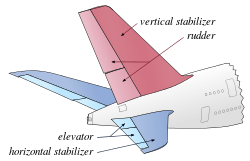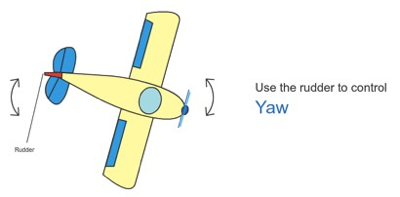Control Surfaces - Air Aerodynamics Flight - Science - Grade 6


Moveable surfaces on an airplane’s wings and tail allow a pilot to maneuver an airplane and control its attitude or orientation. These control surfaces work on the same principle as lift on a wing. They create a difference in air pressure to produce a force on the airplane in a desired direction.





Ailerons Controls Roll On the outer rear edge of each wing, the two ailerons move in opposite directions, up and down, decreasing lift on one wing while increasing it on the other. This causes the airplane to roll to the left or right. To turn the airplane, the pilot uses the ailerons to tilt the wings in the desired direction.

The Rudder Controls Yaw On the vertical tail fin, the rudder swivels from side to side, pushing the tail in a left or right direction. A pilot usually uses the rudder along with the ailerons to turn the airplane.

The Elevator Controls Pitch On the horizontal tail surface, the elevator tilts up or down, decreasing or increasing lift on the tail. This tilts the nose of the airplane up and down.
An Airplane’s Tail: Maintaining Stability
The main purpose of the tail is to provide stability. If tilted by a gust of wind, a stable airplane tends to recover, just as a ball lying at the bottom of a bowl will roll back to the center after being disturbed.
What does a plane’s “Tail Fin” do?
A vertical stabilizer, or tail fin, keeps the airplane lined up with its direction of motion. Air presses against both its surfaces with equal force when the airplane is moving straight ahead. But if the airplane pivots to the right or left, air pressure increases on one side of the stabilizer and decreases on the other. This imbalance in pressure pushes the tail back into line.
What is an airplane’s “Rear Wing” for?
Like the vertical stabilizer, the horizontal stabilizer helps keep the airplane aligned with its direction of motion. If the airplane tilts up or down, air pressure increases on one side of the stabilizer and decreases on the other, pushing it back to its original position. The stabilizer also holds the tail down, countering the tendency of the nose to tilt downward — a result of the airplane’s center of gravity being forward of the wing’s center of lift.
Think you’re good enough to work for Polsky Airlines? Do you have what it takes?! Welcome to your job interview.
You need to show how you can make your plane go in a specific direction using combinations of the Ailerons, Elevators and the Rudder. Good luck!
Polsky Airlines Job Interview - Flight Simulator